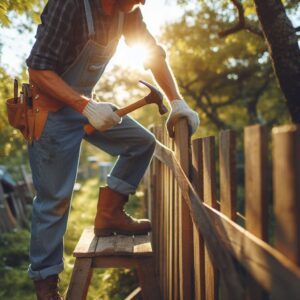Different weather conditions can lead to specific types of fence damage. For wood fences, persistent moisture from rain or snow can cause rotting or the development of mold and mildew. Prolonged exposure to heat and sunlight can dry out and crack the wood. Metal fences may corrode or rust when frequently exposed to rain and humidity, whereas vinyl fences can become brittle and less resilient under UV radiation.
To identify weather-related damage, regularly inspect your fence for signs like discoloration, moisture damage, rust, or brittleness. Early identification and treatment of these issues can extend the life of your fence, preventing the need for more extensive and expensive replacements.
Wood fences are particularly susceptible to pest invasions. Termites and wood-boring insects can cause significant structural damage, leaving behind weakened areas or holes in the wood. Fungal growth can also compromise the integrity of your fence, with organisms such as dry rot spreading through the wood.
Keep an eye out for powdery residues, small holes, or crumbling wood, as these are tell-tale signs of pest and fungal issues. If detected, it’s important to address these problems promptly to prevent further deterioration.
Ground movement is often an overlooked cause of fence problems, but it is nonetheless a significant one. Seasonal changes in soil moisture and freezing temperatures can lead to ground heave, which could shift fence posts out of alignment. This results in a leaning fence or misaligned gates.
You may notice that the fence doesn’t sit straight or that gates no longer close properly. Such changes warrant an inspection of the fence foundations for possible ground movement.
Accidents happen, and fences are by no means immune to them. An errant vehicle, or simple human error, the damage can range from minor cosmetic dings to major structural harm.
Look for broken boards, dents, or other signs of force. Where accidental damage occurs, it’s important to assess the extent of harm to ensure that what seems like a minor issue doesn’t compromise the overall stability of the fence.
Over time, general wear and degradation are to be expected with any outdoor structure. Components of the fence may come loose, screws and nails may corrode or become displaced, and materials can start to wear down after years of exposure to the elements.
This type of wear may not always be immediately obvious, so it’s best to conduct periodic inspections to check for signs like loose boards, missing hardware, or sagging sections of the fence.
Repair Tactics for a Sturdy Fence
Wooden fences are highly susceptible to issues like rot, insect damage, and warping. When dealing with rot, it is important to remove the affected sections to prevent the rot from spreading. This involves cutting out the rotten piece and replacing it with fresh, pressure-treated wood that withstands environmental challenges more effectively.
For pest control, you may need to replace the damaged sections of the wood and treat the fence with an insecticide designed for wood-infesting pests. Always ensure that any pesticide used is suitable for residential use and follows environmental guidelines.
Warping in wooden fences can be caused by uneven drying or exposure to moisture. Depending on the severity of the warping, you may need to either physically straighten and secure the warped boards or replace them entirely.
 Metal fences might show signs of corrosion or rust. The initial step for repair is to remove the rust by using a wire brush or sandpaper. After cleaning the affected area, apply a rust-inhibiting primer followed by paint matched to the original color of the fence.
Metal fences might show signs of corrosion or rust. The initial step for repair is to remove the rust by using a wire brush or sandpaper. After cleaning the affected area, apply a rust-inhibiting primer followed by paint matched to the original color of the fence.
Should you find any bent or damaged sections, particularly in a chain-link or wrought iron fence, the repair may involve bending the material back into shape or substituting the compromised section with new fencing material. Ensuring all connections are secure and that the frame of the fence is intact is also necessary for maintaining firmness and structural integrity.
Vinyl fencing is valued for its durability and low maintenance, but it can still suffer from cracking or breaking under impact or extreme temperatures. Small cracks can often be fixed with vinyl glue or a specialized repair kit. For larger breaks, replacing the affected panels is usually the most reliable repair method. When replacing panels or posts, confirm that the new vinyl matches the existing fence in color and style to maintain a consistent appearance.
Ground movement can cause a fence to lean or become unstable. This problem often originates from the fence posts. If a post is leaning, it may require repositioning or additional support. This might involve digging out the existing post hole and setting the post in a new concrete footing. It is important to ensure that the post is vertically straight using a level before the concrete sets.
If the issue is related to ground heave or soil erosion, you may need to consult with a professional to assess whether more extensive ground stabilization measures are required to protect your fence from future shifts in the soil.
Consistent maintenance is an effective way to minimize the need for repairs. Wooden fences benefit from periodic staining and sealing to protect against moisture and sunlight. Metal fences require regular checks to catch and address rust or loose components. For vinyl fences, cleaning with a hose and a mild detergent can prevent the buildup of dirt and grime that can lead to material degradation.
It is recommended to periodically tighten any loose hardware, reinforce any weak points, and ensure that gates are properly aligned and functional. By dealing with small issues promptly, you can prevent them from becoming major concerns that may require more significant repair work.